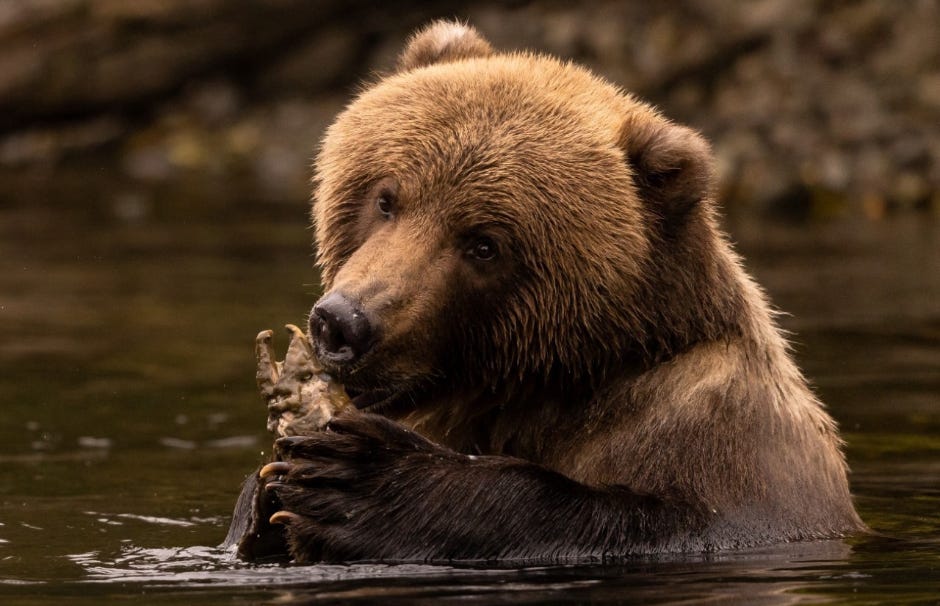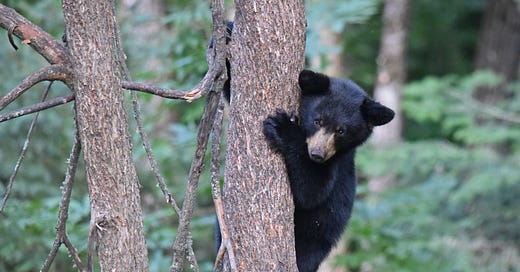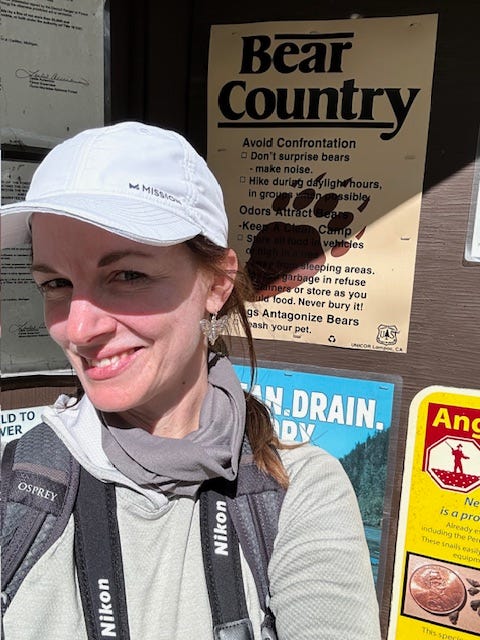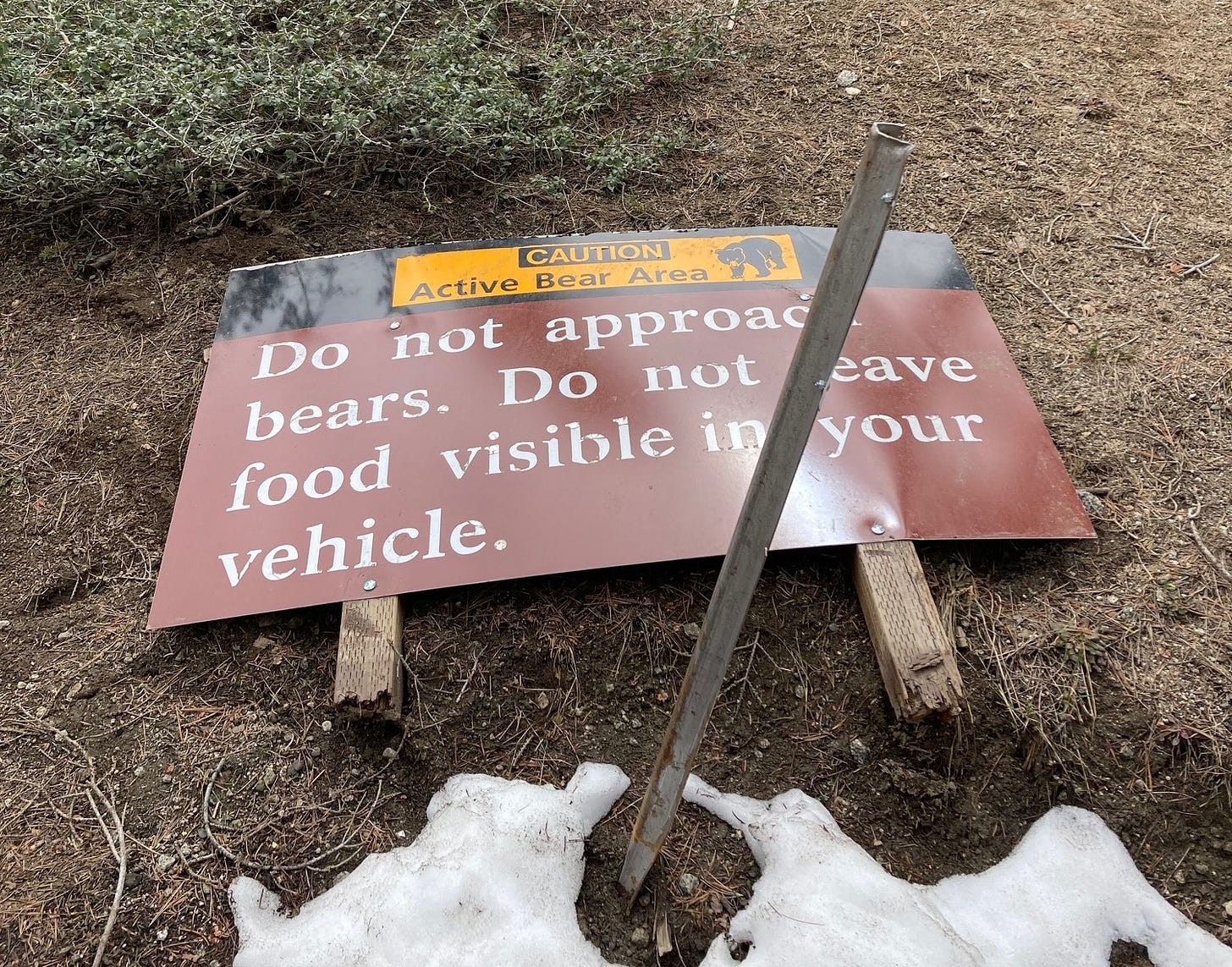Yes, Michigan, there are bears in these woods
An estimated 10,000 black bears live in Michigan. I've met three of them.
“We don’t have bears in Michigan, do we?”
This was asked by a teammate at a recent parks-themed trivia night hosted at a brewery that caters largely to a flannel-wearing, moss-appreciating crowd. This is the kind of place where the TV over the bar broadcasts live footage from nest and feeder cams — the vibes are immaculate.
We were stuck on the question of which mammal does not make a home on Michigan’s Isle Royale National Park – wolf, black bear, red fox or moose? We had zero doubts that gray wolves live on the rugged island, as do moose, but could the ecosystem support two apex predators?
I reasoned that I’d seen both a grizzly bear (snoozing at a safe distance) and a wolf (again, at a distance, loping across the wide expanse of the Lamar Valley) in Yellowstone National Park, so it was possible for bears and wolves to overlap. But with Yellowstone at 3,400-plus-square-miles and Isle Royale’s main island at just over 200-square-miles, there’s less space for the two alphas to comfortably commingle.
In the end, we discarded the red herring of the red fox, and chose correctly with bear. But my teammate’s doubt at the prospect of bears in Michigan was the perfect segue to share one of my favorite Michigan wildlife stories. With the gentlest of prompting by another teammate (and frequent hiking buddy), I offered up the elevator pitch-version of the tale.
You, gentle reader, will get the full scoop.
And now, my Michigan bear story.
Every spring for the last decade or so, my husband Adam and I spend a long weekend in a tidy little rental cabin just outside of Grayling on the famed Au Sable River. For the unfamiliar, Grayling is generally agreed to be about where the invisible line of “up north” begins in Michigan. It’s the county seat and only incorporated community of Crawford County. Even then, fewer than 2,000 people live within the city limits, according to the 2010 census.
The region is part of the Huron-Manistee National Forests, and two of the state’s most beautiful rivers – the aforementioned Au Sable and the Manistee – run through. There’s a lot of trees, a lot of logging and a lot of wildlife but not a lot of people

My favorite Grayling haunt is the Wakeley Lake Area, which I hike at least a few times each visit, sometimes multiple times a day. It’s managed by the US Forest Service – which hopefully still exists as you read this – and offers hiking, primitive camping and limited fishing. It also offers solitude and a whole hell of a lot of birds. The 2,100-acre area provides nesting habitat for common loons and bald eagles, and I’ve had the good fortune to see and hear both species with regularity when visiting. On hikes over the years, I’ve also seen barred owls, osprey, Virginia rail, spring warblers and other migrants, porcupines, turtles, snakes, muskrats, wood ducks, Sandhill cranes, and dozens of interesting plants, animal burrows and ephemerals to test my burgeoning ID skills. It’s a special place, and every visit offers something unexpected and awe-inspiring.
I’m getting there, I swear. But first, just a tiny bit more about bears.
To set the stage for my relationship with bears: Adam and I traveled to Alaska a decade ago to visit my childhood best friend who’s lived in the Last Frontier on and off for 20-plus years. Our vacation was built around outdoor activities, so I studied up on the importance of being Bear Aware. Where you’re most likely to see a bear. How to identify signs that you’re in the proximity of a bear. What to do if you encounter a bear. What to do if you have angered the bear. What to do if the now-angry bear is charging you.
I was nervous. I was excited. I was ready.
We visited in early fall, peak time to catch the end of the salmon run, when “zombie” fish return to their hatching grounds to spawn and die. The grizzlies, in crunch time to fatten up for winter, gorge themselves on the bloated, rotting carcasses, and it’s almost guaranteed you’ll see a bear if you hike near a river. These circumstances demanded extra vigilance (and bear spray), my friend/tour guide warned. And yet – we saw all kinds of incredible wildlife, and didn’t see one bear.

A few years later, we spent a week-plus in Colorado and Wyoming, where, once again, I was on very high alert for bears. Either I wanted it too much, or all of my Bear Aware trail noises (rock clacking, humming, occasionally shouting “Hey bear!”) were effective – no sightings or encounters. We did get that aforementioned look at a grizzly in Yellowstone. It was passed out next to an elk carcass it had been picking at for several days, and was visible only with a scope. Honestly, it was so far away, it might as well have been on the moon.
In spring 2020, a black bear wandered into the city limits of Grand Rapids, where we live. Not out of the realm of possibility, but certainly unusual. The bear was spotted in my neighborhood. My neighbor watched it run through MY FRONT YARD. But do you think I saw that bear? No. I did not. Sadly, after a few days of city living, the poor bear wandered onto a nearby highway and was struck and killed by a truck.
All this to say – bears were something of an elusive obsession for me. An unrealized threat and unfulfilled promise of experiencing an apex predator in its natural habitat.
Now that I’ve probably built it up too much, here’s the actual story.
During our 2021 visit to the Grayling cabin, our second day, I went for my standard afternoon-into-evening hike at Wakeley Lake. There are a few trails of varying lengths, including one that’s about six miles and circumnavigates the entire lake vs. my standard route, which features a shortcut across an elevated grassy levy that lops off the top wetland section of the lake.
Like many non-park public lands, Wakeley Lake is free of the kind of human crowds you’d find in a popular national or state park. Most visits, I encounter anywhere from zero to a handful of mostly respectful people.
The trail signage isn’t terrible – I’ve certainly seen worse – but it’s not amazing, and the blaze system isn’t particularly robust. Even still, if you’re familiar with the trails, it’s pretty easy.
Here’s where I started to rack up the errors on this particular trek:
The late spring weather was mild, and I can go a long time without eating or drinking, so I didn’t bring much water or any snacks.
I looked at the trail map before I set off, but I didn’t accurately estimate the mileage-to-trail time, coupled with failing to account for my unfamiliarity with the northern third of the trail. I assumed the new-to-me portion of trail would be as self-evident as the sections I’d hiked numerous times. I didn’t download a map; I relied solely on trail markers, without knowing if said trail markers … actually existed.
Complacency. Just overall phoning it in, as far as preparation and situational awareness are concerned. It goes without saying, but I’ll say it anyhow: never do this when hiking, especially alone.
The first half of my hike was smooth. From the parking lot, I walked north, turning west at the trail’s first fork, hugging the southern edge of the lake. There’s a well-maintained boardwalk that skirts the shore, cuts across the wetlands and provides a good look at marshy birds. It also gives nesting red-winged blackbirds the opportunity to hurl insults at you.
From there, the trail gently rises, providing elevated glimpses of the lake between the pines. Looking back at my eBird list from that hike is wholly underwhelming (2 Canada goose, 1 killdeer, 1 Eastern kingbird, 1 white-breasted nuthatch) but I suspect I became distracted and never completed the list before submitting. Let’s assume I saw many of the usual suspects – blue jays announcing my arrival, wood ducks crashing away in an effort to remain undetected and so on.
I adhered to my familiar route until reaching the turnoff point to take “the long way” around the farthest reaches of the lake. Here’s where things started to go south, so to speak. By this point, trudging up and down the hilly, western side of the lake, my thirst was starting to outpace my water ration. Calculating the remaining trail time vs. remaining daylight vs. remaining potable water, I should’ve bailed on exploring new terrain, and instead, headed due east to cut across my usual shortcut. Instead, I stubbornly aimed northwest to continue around the lake.
This was a mistake for all of the reasons I’ve already mentioned as well as this: this portion of the trail kind of … sucked? Now, yes, yes, all ecosystems and habitats are interesting, unique and valuable in their own right, but this portion of the trail was a pale facsimile of my usual trek. Instead of getting glimpses of the northern edge of the lake, or additional marshlands, I was dragging through sandy pine habitat. This is fine on most days, but as my thirst intensified and the late afternoon heated up, I was parched and a little grumpy.
And then I got lost. I reached a poorly marked, overgrown fork in the path and veered the wrong direction. I wandered until I emerged from the woods onto a dirt road. “Heh, heh. This isn’t right,” I thought, spinning around and tamping down the panic as I pulled up Google Maps to try and discern where I was and where I needed to be. Finding little help, I opted to double back to the last wrong turn. Thankfully, once I neared the trail, my new direction revealed a previously obscured trail marker not visible when coming from the south.
Great. I was back on track, and with daylight slipping away, I picked up the pace and kept my head on swivel for blazes and other trail markers. I hauled ass until the portion of the trail I was on reconnected with the “shortcut” and I was safely returned to familiarity. I kept a brisk pace, knowing I had several miles left to get back to the parking lot – I was not prepared or equipped to be on the trail alone after sunset.
As I blasted through the end of the upland jack portion of the trail and moved closer to the dense conifer swamp (you know what kind of animal loves a dense conifer swamp??), my brain marginally registered two things that in hindsight, were stunningly obvious clues: a tree trunk etched with deep claw marks, and a pile of rather fresh, suspicious-looking scat.
But I was a hiker on a mission, and the only thing occupying space in my brain = get to the car before the sun goes down. Adam had been wading the Au Sable that evening, and I didn’t want him to worry about my being alone in the forest after dark.
By now, I could anticipate every dip and curve in the trail, and knew I was within reach of the primitive campsites closest to the lake. I could “smell the barn” as it were. My shoulders relaxed and I considered if I’d have time to pause at the lake’s edge to look for the loons — maybe I’d get to hear their eerie cry to send me on my way? As I approached the 90-degree bend that would lead me to the lake, I caught sight of a large, dark furry thing emerging from the brush about 30 to 40 feet in front of me. “Oh crap. A dog. I’m out here all alone with some dude and his dog,” I thought, dipping immediately into my waistpack for my pepper spray and phone.
I then noticed the second large, dark furry thing following the first. And then a third. My brain finally pieced all of the information together: It was a mother black bear with her two cubs. I was all alone and seconds away from startling a mama bear with her babies. I’m a birder, remember, so I can move with stealth through the woods. Generally speaking, bears do not like to be surprised. They’re like lawyers that way.
“If it’s brown, lay down. If it’s black, fight back. If it’s white, say goodnight” I quickly recited to myself, trying to draw on the actual advice gleaned from all of the various Bear Aware indoctrinations I’d subjected myself to prior to going out “out West” “where all the bears live.”
“Am I supposed to chase after the bear and try to fight her? No, that can’t be right.”
I followed the ursine troupe with my eyes, and silently, slowly backed up a few feet while contemplating if I needed to backtrack the entire six-plus miles to reach the parking lot from the other direction.
I theorized how helpful it would be if an unseen force could gently pick me up by the back of my shirt and gently move me above the trees, setting me down at the trailhead, much like you can drag and drop that little human avatar on Google Maps.
“Maybe Adam can drive here and rescue me?” Setting aside the fact I had both sets of keys (oops), how would that work, exactly? Would I stall the bear just long enough for Adam to come crashing through the forest in my sedan?
So many mental calculations at once, so few of them helpful. After I allowed the first — and dumbest — ideas to wash over me, I positioned myself to watch the (agonizingly slow) progress of the bears. I unlocked my phone and called Adam.
“There’s a (expletive) mama bear and her babies on the trail. I can’t get around them – I’m going to have to go past them. What the (expletive) do I do?”
We immediately agreed that I needed to make enough noise to scare away the bear. I switched to speaker phone and began yelling at the bears while Adam furiously Googled something along the lines of “bear, woods, wife?????.”
“BE GONE, BEAR! BEAR, BE GONE! I AM A HUMAN! BE GONE!!” I waved my arms and yelled at the bear, who paused and (I shit you not) fully stood up on her hind legs like a person to watch me.
“Oh my god, why can’t I think of anything better to yell at this bear besides ‘be gone’? I sound like Frasier Crane,” I said, though I don’t know what would have been better to shout? “Bear, I am a human. My name is Tricia and I have a family and many friends and three cats. They will miss me very much. They will come looking for me.”
“The internet says only one in 1 million black bears will attack,” Adam said.
“OK, but DOES THE BEAR KNOW THOSE STATISTICS?” I countered, continuing to wave my arms helpfully at the perplexed animal.
The last of the bears ambled off the trail and further into the other side of the brush, heading on a parallel path to the lake. I began slowly, steadily inching ahead, never turning my back on the trio. I spoke loudly and calmly(?) every step of the way, describing the situation to Adam between (probably desperate, let’s be honest) cries of “BE GONE, BEAR!”
The mother bear paused a few more times to glance back at me, but she appeared more curious (and eventually, bored) than anything. Certainly not aggressive. I walked backward on the trail for a bit, keeping her in my sightline as long as the trees and fading light would allow. When I was confident she was out of range, I turned and sprinted the half mile or so back to the car – not easy for a non-runner, but fear is an incredible motivator.
When I reached the parking lot, I unlocked my car with shaking hands. Safely inside, I hung up the phone, locked the doors and exhaled. My stomach churned and my limbs ached as the post-adrenaline fatigue slammed into my body. I was OK.
So … what’s the lesson here? What did the bear teach me?
This post wasn’t solely an excuse to trot out one of my favorite hiking stories. It’s also a reminder that “wild things” aren’t limited to national parks, or unfamiliar, rugged landscapes. At the time of this encounter, I knew full well that Michigan is home to black bears. I’d driven past billboards in Grayling warning residents to take down their bird feeders in the spring. Hell — a bear ran through my own front yard the previous year.
The Michigan Department of Natural Resources reports there were just over 10,000 black bears in Michigan in 2022, an increase of 21% from 2012. They’re out there.
But because I’d never seen — or heard about — one at Wakeley, I didn’t think about it. In 2021, there were no signs on the parking lot bulletin board warning of the presence of bears. (Ticks and beavers, yes, but not bears. They have since added Bear Country signage.) And in spite of my deep connection to nature, I was still guilty of thinking in terms of “the wild” as being “out there somewhere” [vaguely gesturing toward the American West].
It simply never crossed my mind that I would encounter a bear on this trail because I hadn’t been told I might.
This is important from a safety standpoint – while black bears tend to be shy and non-aggressive, they’re still wild animals, and apex predators at that. Just because they appear at grandpa’s bird feeders or rummage for peanut butter sandwiches at busy campgrounds doesn’t mean they’re the equivalent of squirrels.
The National Park Service, in the bluntly-titled “Bear Attacks,” warns: Every encounter is different. Bears exhibit different kinds of behaviors during different situations, and understanding the bear’s behavior can make the difference between life and death.
According to the “What if I surprise a bear?” section, my instincts and actions in the woods that day were on point, fueled, in part by my natural tendency to favor option three in the biological “fight, flight or freeze” sequence.
I didn’t antagonize the bear (obviously some people do, or they wouldn’t need to include that caveat).
I spoke calmly to the bear (there’s no witnesses or video to contradict this assertion).
And I didn’t immediately run.
Also, genuinely? I don’t think the bear cared about me. I was lucky, because while Wakeley does get campers, facilities are limited, so I don’t know how much contact the bear had had with humans and our food. Good news for me because a bear that associates humans with something as irresistible as Doritos is a danger to itself and others.
I didn’t take any more evening hikes at Wakeley for the remainder of that trip, and I was on high alert for the rest of the hiking season. But by the next spring, I was back to my usual treks — albeit better prepared and better hydrated. I’m still more concerned about tick safety than worrying about bears. But I am much more grounded in the reminder that this is nature, and you cannot predict who you’ll encounter out there. That unexpectedness is what makes the outdoors so special and worthy of our respect.
References:
MLive - Black bear in Grand Rapids (aka RIP Big Fella)







Great post, Tricia! My heart was pounding for you. When we visited Alaska, we saw bears in Anchorage (from the safety of a car), but we had one stressful hike to a remote lake, where a sign was posted that there was a bear kill at the lake that morning. I did a lot of yelling, "Hey bear" that day. I've had good luck seeing bears in the Smokey Mountains. We went in late April a couple years ago, and there were tons of bears out. I couldn't believe all the people getting out of their vehicles to get a better picture up close! We ended up skipping some hikes after we saw bears near the parking areas. Final bear story: I can't recall ever seeing one in Michigan, but I'm pretty sure one walked near my parents' house one summer night. I could hear something outside, and a horrible smell came through the open window at the same time. It was too dark to see, but I'm guessing it was a bear passing by.